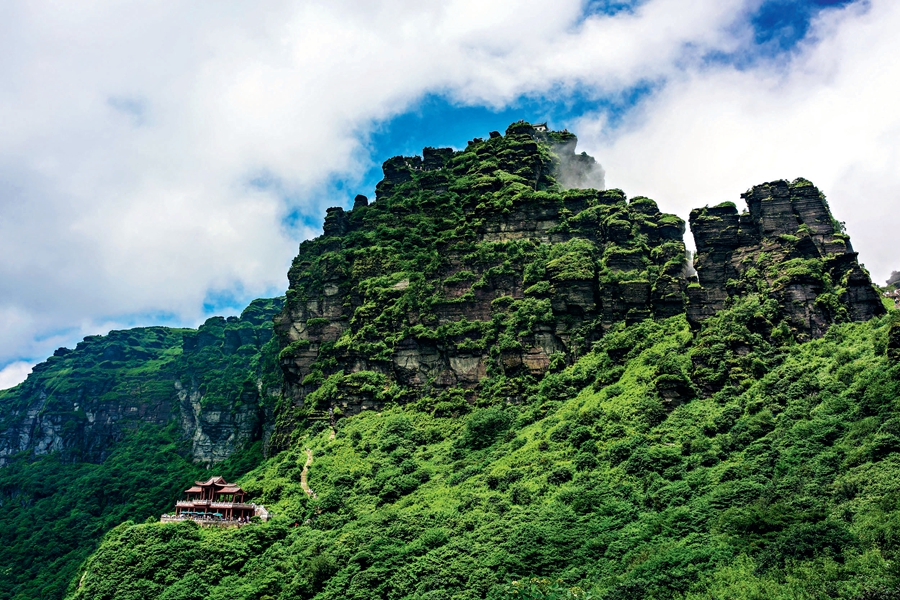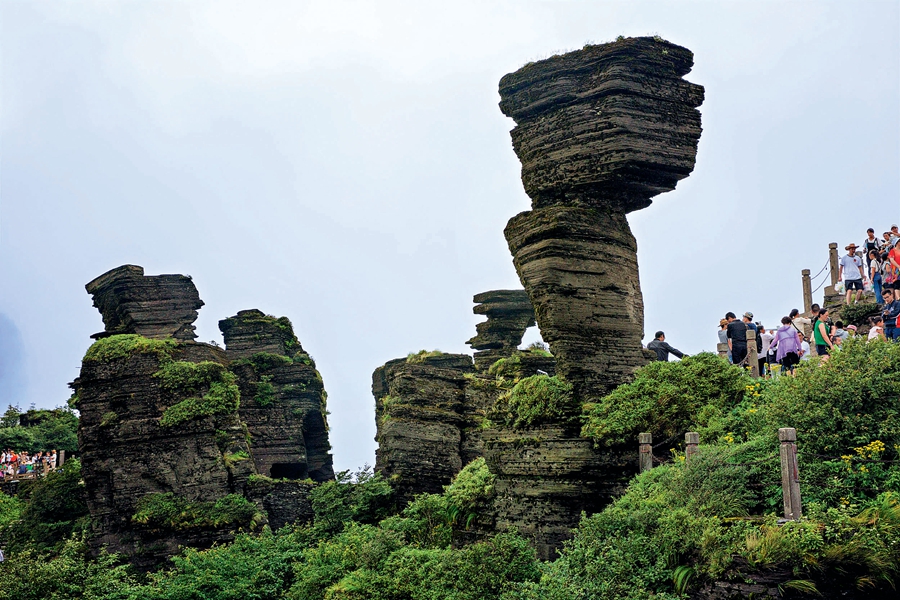MOUNT Fanjing National Nature Reserve is located in the northeastern part of Tongren City in the Province of Guizhou. With a total area of 43,411 hectares and 96.5 percent forest coverage, this nature reserve is home to many rare and endangered species such as the grey snub-nosed monkey, the Chinese Dove tree, the Fanjingshan Fir tree, and an old-growth forest ecosystem. Inside the nature reserve, one can find layer upon layer of mountains and valleys, clear streams flowing into deep blue lakes, and in winter, mighty frozen waterfalls that form shimmering ice cascades, making for an even more spectacular landscape.

Mount Fanjing.
In January of 2013, Tongren City officially applied to be considered a world heritage site. In October of 2013, Fanjing was added to China’s tentative list of national natural heritages. In February of this year, together with UNESCO, China formally supported the application of Guizhou’s Mt. Fanjing for World Heritage status. These applications aim to protect Mount Fanjing’s old-growth forest ecosystem and rare flora and fauna, while at the same time exploiting its ecological products, promoting sustainable local socio-economic development, and ultimately achieving a productive balance between protection and development.
A Diverse Ecological Environment
Mount Fanjing is the tallest peak on the slopes that run from the Yunnan-Guizhou Plateau to the hills of western Hunan. From base to summit, it stands 2,000 meters tall and is the tallest peak in the Wuling Mountain Range. On its slopes grow 44 different types of forests, including vast old-growth forests. The stable balance of the ecological environment allows for the conservation of flora and fauna that dates back to the 3rd and 4th centuries. It is one of the best-protected forest ecosystems on the same latitude across the globe.
Mount Fanjing protects the world’s scarce subtropical primary ecosystem, including over 6,000 biological species – about 3,000 plant species and 3,000 or so animal species. Among these, many wild animals have received national protection, like the grey snub-nosed money, a.k.a. the only child of the world, which is an endangered species on the verge of extinction and has been placed on the red list of threatened species and given a grade of “EN” by the International Union for Conservation of Nature (IUCN). Mount Fanjing is the only home of the grey snub-nosed monkey, according to the latest research; the grey snub-nosed monkey inhabits an area of only 260 square kilometers in the heart of the Fanjing nature reserve, and is active across an area that is no bigger than 400 square kilometers.
The Chinese Dove tree is a species peculiar to China and a national conservation priority. Other than those sporadically distributed throughout the Fanjing nature reserve, there are also 13 Chinese Dove Tree forests with a total area of about 80 hectares. Today, this area boasts one of the world’s highest concentrations of wildlife.
Other than snub-nosed monkeys and Chinese dove trees, Fanjing nature reserve is also home to a number of ancient and rare flora and fauna, such as Maidenhair Trees, a.k.a. Ginkgo Biloba, Tulip Poplars, and Chinese Yews. The abundance of these biological resources have enormous scientific and academic value; it forms an ideal practice ground for education and research in the fields of biology, ecology, genetics, meteorology, geology, and forestry. In recent years, scholars and experts from research institutes and universities from all over the world have conducted studies and research in the nature reserve.
In addition, Mount Fanjing is the primary river source for the Tongren region; it is the watershed of major Yangtze River tributaries, such as the Wujiang River and the Ruanjiang River, thus making it an important area for water conservation. The Fanjing nature reserve serves as a large natural reservoir, providing over 10,000 cubic meters of water to the local Jinjiang, Yinjiang, and Songjiang rivers.
Strengthening Biological Resource Management
In 1956, the Ministry of Forestry started to ban logging on Mount Fanjing in the interest of managing and conserving its national forests, putting an end to the destruction of the core area of Mount Fanjing by the surrounding areas. In 1978, the Ministry set up the nature reserve and established managing organizations, thus putting th

Mount Fanjing in Tongren of Guizhou Province is endowed with stunning natural beauty.
Since the establishment of the reserve, the working policy of “scientific investigation as support, management and protection as the foundation, and coordinated development of local communities as a guarantee” has been in effect. This has included uncovering Fanjing nature reserve’s biological resource background through conducting background surveys of biological resources and investigations on the exterior ecology of snub-nosed monkeys, and has provided the foundations for the protection and management of biological diversity and reasonable resource exploitation.
In order to scientifically manage and protect the natural resources, the reserve has collaborated with national and foreign institutes of higher learning and research to study the geological landforms, lichen, moss, macro fungi, ferns, herbage, woody plants, forest vegetation, soil creatures, arachnids, fish, amphibians and reptiles, bird, and mammals, which has had substantial scientific payoffs. At the same time, over 200 infrared camera platforms have been installed in different habitats and altitudes throughout the park to observe animal activity and the effects of tourism on wildlife, as well as provide year-round monitoring of epidemics along the periphery of the reserve.
In order to better gather and disseminate information about Mount Fanjing’s natural resources and ecosystem, inside the reserve is an exhibition center, a wildlife rescue center, and scientific information plaques. In addition, along the forest path of the ecotourism area, there are display panels that provide information about the flora and fauna, ecology and conservation, and tourists can wander around in the big natural oxygen bar and learn.
Reconciling the Development/Conservation Paradox
The Mount Fanjing nature reserve has implemented community co-management, whereby many parties participate in the process of policy formulation, implementation, and evaluation of the conservation management plan. After years of community co-management work, they have accumulated particular experience and proposed the idea of a “big neighborhood.” This intends to not only develop relations of community co-management among the towns and village groups, but also expand the neighborhood to all sectors related to the productive activities of the community residents, in order to build all-round support for construction within the reserve.
Coordinating the development of local communities and the reserve, and community co-management are a guarantee of perfecting the work of the reserve. The Mount Fanjing periphery is home to 13,000 people in seven villages across the three counties of Jiangkou County, Yinjiang Tujia and Miao Autonomous County, and Songtao Miao Autonomous County over a total area of 434 square kilometers. Nearby villagers have lived together with Mount Fanjing for generations. They rely on hunting, trapping, collecting Chinese medicinal materials, and moderate logging to survive. The major problems within the community stem from economic income being highly tied to agricultural production, the generally low standards for resource exploitation, the scarcity of economic forests, poor transportation and infrastructure, and the hidden dangers of poaching and natural disasters. These factors put huge strains on local development; only through improving their living conditions can a harmonious balance between people and nature be achieved.
Financial support provided by the local government is very limited. The employment of locals by the tourism management in Mount Fanjing provides some income relief for the residents, while the remaining funds provide subsidies for the development of remote communities and provide them with infrastructure such as water canals. The reserve management bureau has also used a special fund to distribute 1,000 induction cookers throughout the neighborhoods surrounding the reserve in an effort to reduce the consumption of forest resources; it provided 50,000-60,000 Chinese fir seedlings for reforestation, which has played a role in resource sustainability; and through various channels, has organized and developed multilevel and multiform skill training (especially in the industries of fish and chicken farming, crop farming, catering and service) in order to deal with the labor surplus of the surrounding area, raise the income of village residents, and reduce their dependency on forest resources.
Reconciling the paradox of economic development and environmental protection starts with resolving the issues of farmers’ livelihood.
Mount Fanjing is a sacred Buddhist mountain. Historically, there is a tradition of making pilgrimages to mountains. Early in 1987, a pilgrimage path was constructed within the reserve, however, the journey up and down the mountain took at least three days, there was no rapid transportation and pilgrims had to seek accommodation along the way making obvious footprints on the park. To allow for speedier pilgrimages and reduce their impact on the environment, in 2002 the local government proposed constructing a cable car. But would its construction have destructive effects on the environment? To answer this question, the State Forestry Administration held an expert round table, and sent experts into the field to investigate. In the end, only after it was determined that the environment would not be disturbed, was the cable car built.
In 2009, the cable car was put into use; tourists could now ascend the mountain in 15 minutes. The cableway is above the top of the trees and there is no passage below the ropeway. Therefore, there was no need to fell trees and it has had almost no effect on the growth of the trees. The traditional pilgrimage path has been refurbished so that pilgrims can still climb the mountain by foot. Every thirty-minute walking distance there is a resting point where tourists can buy water and snacks. All of the staff and personnel are hired from the local communities. There are no hotels or restaurants in the scenic area and all of the facilities are built outside the area. At night, the whole Fanjing nature reserve scenic region is quiet and dark, the purpose is to allow the plants and animals a chance to rest and recuperate, and allow nature to rehabilitate.
In 2015, the Fanjing nature reserve was named a “National Forest Oxygen Bar.” In 2005, it greeted less than 50,000 tourists a year, by 2015 that number was multiplied tenfold. This has provided the local communities with many employment opportunities, hoisting the economic development of the surrounding areas and bringing greater prosperity to the local people. In addition, the population of snub-nosed monkeys inside the reserve has grown, the Fanjingshan Fir Tree has been restored to its original state when the reserve was first established and the Chinese Dove trees have spread and grown denser. Other rare and endangered species, as well as the primitive forest ecosystems, have received effective protection.